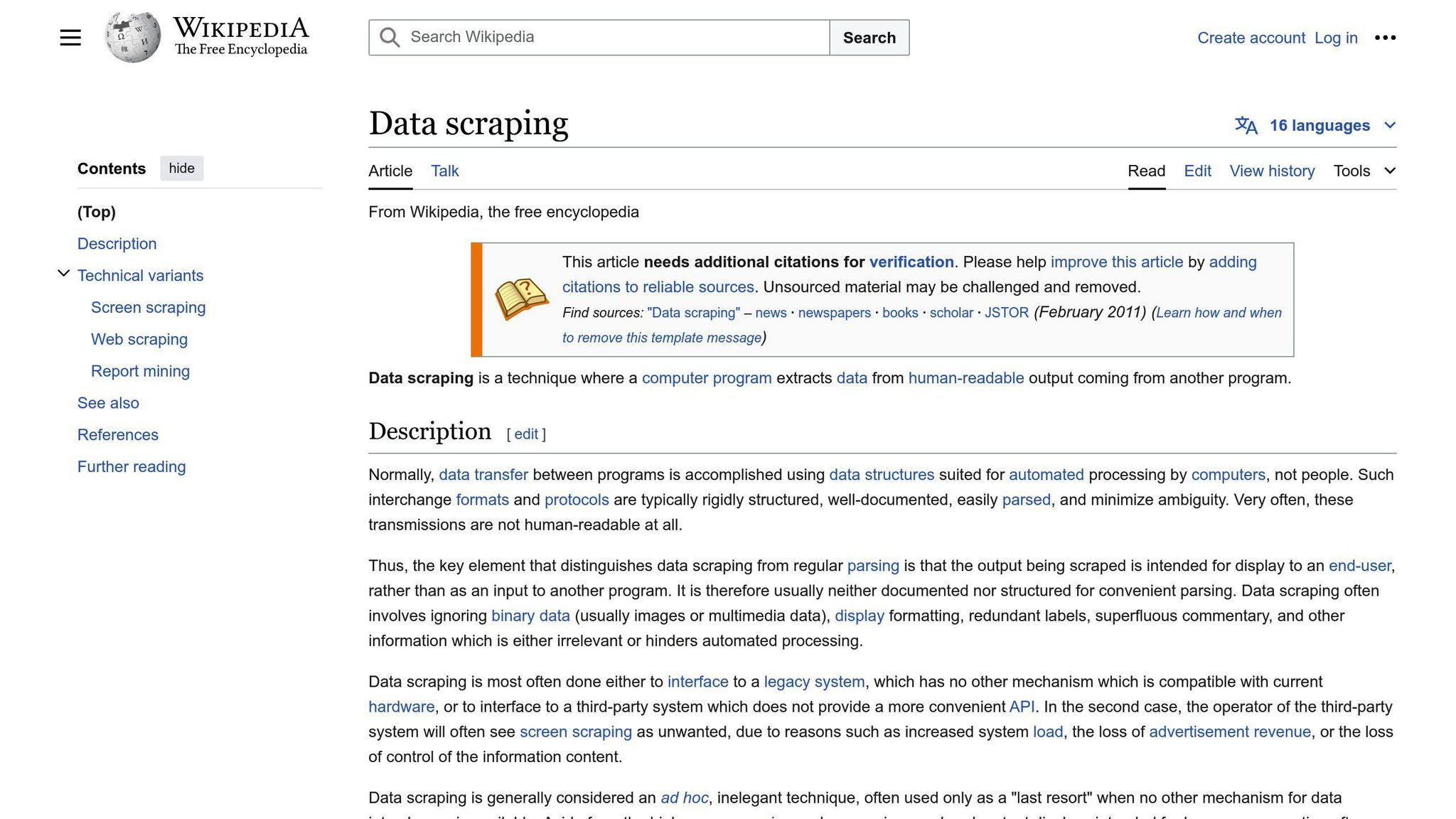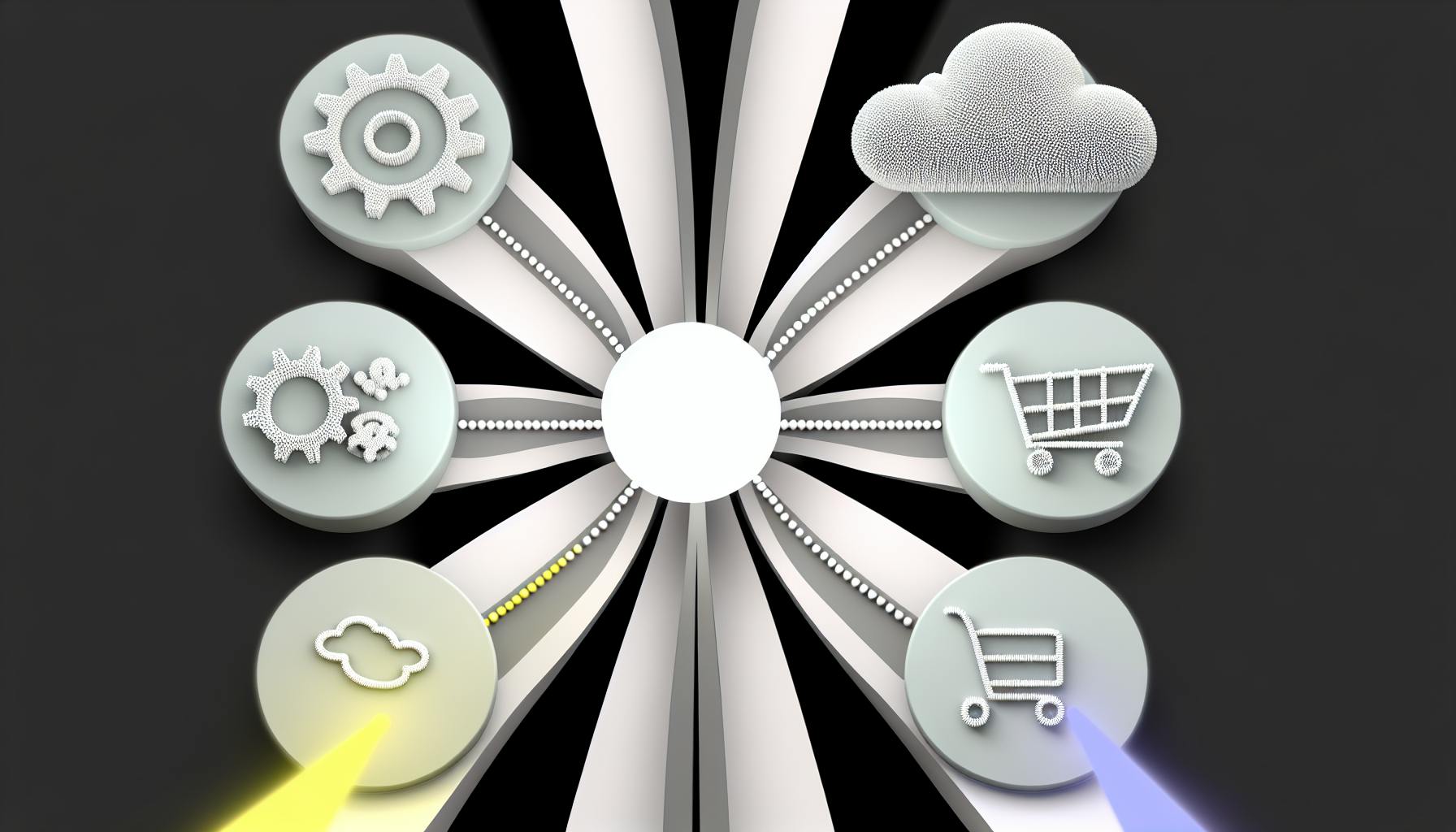Product data scraping is an efficient way to gather detailed information about products from the web. This method helps in collecting data on prices, features, reviews, and more, directly from websites, aiding in market research. Here's a quick overview of what product data scraping involves:
- Automatically Collecting Information: Tools like AIScraper automate the process, fetching data on product names, prices, reviews, and more.
- Benefits: It offers competitive benchmarking, market trend analysis, and enhances data-driven decisions, among other advantages.
- Preparation: Define your data needs, choose the right tools, and identify reliable data sources.
- Execution: Configure your scraping tool, adhere to best practices, and troubleshoot common issues.
- Analysis: Organize and analyze the scraped data to uncover market trends, consumer preferences, and pricing strategies.
- Scaling: Integrate proxies and CAPTCHA solving to scrape at scale and automate the process for regular updates.
This approach provides a comprehensive view of the market, helping businesses make informed decisions and stay competitive.
Key Benefits of Product Data Scraping for Market Research
- Competitor Benchmarking: Keep an eye on what other companies are selling and how their prices change. This helps us stay competitive. For example, platforms connecting homeowners with trusted professionals uses product data scraping to monitor pricing and service offerings of competing home repair and remodel services, allowing them to adjust their strategies and maintain a competitive edge in the market.
- Market Trend Analysis: Use sales data to see which product features or categories are becoming more or less popular.
- Optimize Product Portfolios: Find out what products or features customers are missing, giving us ideas for new items.
- Enhanced Data-Driven Decisions: Add up-to-date web data to our regular research methods for better decision-making.
- Lower Costs: Collecting data automatically is cheaper and faster than doing it by hand.
Using simple tools, product data scraping lets us keep up with market trends efficiently and affordably. It gives us the latest information to make smart, data-driven choices and stay ahead in the market.
Preparing for Product Data Scraping
Before you start grabbing product info from websites, it's important to know what you're looking for and why. Here's how to get ready:
Defining Your Data Needs and Objectives
-
First, think about the kind of information you need. This might include:
- Names, descriptions, and pictures of products
- How much things cost
- Ratings and what people think about them
- If something's in stock
- Details about the product like size or color
-
Be clear about what you want to achieve. Maybe you want to:
- See how prices change
- Compare yourself to competitors
- Find out what's popular
- Look for product gaps
- Work out the best price
- Decide which pieces of information are most crucial for your goals. You don't need to grab everything.
Choosing Suitable Data Extraction Tools
- Look for tools that are:
- Flexible enough to handle different website layouts
- Able to deal with lots of data
- Offering the data in formats you can use like CSV or JSON
- Smart enough to not get blocked
- Easy for anyone to use, even if you're not a tech whiz
- AIScraper is a good pick because it's user-friendly and doesn't require coding skills to set up.
Identifying Reliable Data Sources
-
Use well-known websites and online shops to make sure the information is accurate. Good sources include:
- Big marketplaces like Amazon or eBay
- Top retailers
- Review sites
- Forums related to your industry
Checking out smaller, niche sites can also offer unique insights, but always check if the information is reliable.
With a clear plan, the right tools, and trusted sources, you're all set to start collecting product data effectively!
Performing Product Data Scraping
Configuring AIScraper for Your Scraping Needs
To get AIScraper ready for collecting product info, here's what you need to do:
- Provide your request in natural language - AI will analyze it and find info for scraping
That’s all!
Analyzing Scraped Product Data for Market Research
After you've collected all this product info from websites, the next big step is to make sense of it. This part helps you figure out what all that data means for your market research. Here's how to do it in a straightforward way.
Organizing Scraped Data in CSV/JSON
When you have a lot of product info, it's important to sort it out so you can actually use it. Here's what to do:
- Put all the data into CSV or JSON files because they make it easier to work with in programs like Excel.
- Or just export to Google Sheets
Uncovering Consumer Trends from Reviews
Looking at what people say in reviews can show you what's hot and what's not. Here's a simple way to do it:
- Use tools in Excel or Google Sheets to see how people feel about products.
- Look for words that pop up a lot in reviews to spot trends. For example, if more people start talking about "battery life," that might be something to pay attention to.
- Sort reviews by their star rating to see what issues come up most often.
- Keep track of how opinions change over time to catch new trends early.
This approach helps you tweak your products to match what people want.
Benchmarking Product Pricing Strategies
Keeping an eye on what others charge for similar products helps you set your prices right. Here's how to use the data you've collected:
- Look at past prices to understand how often and by how much prices drop.
- Figure out how your sales are affected when a competitor changes their prices.
- Plan your discounts around the same time as others to stay competitive.
- Test different prices with the data you have to see what works best for making more money.
Using real data to guide your pricing can help you stand out and sell more.
sbb-itb-9b46b3f
Scraping Product Data at Scale
Integrating Proxies and CAPTCHA Solving
To scrape lots of product data without being stopped, it's key to use rotating proxies and solve CAPTCHAs automatically.
Here are some tips:
- Turn on the proxy rotation in AIScraper to use different IP addresses. This helps avoid getting blocked.
- Use a service that solves CAPTCHAs for you, like 2CAPTCHA, so your scraping doesn't get stuck on these checks.
- Make sure your scrapers act like real people by browsing slowly and taking breaks. This helps them blend in.
- Have a bunch of residential proxies ready for scraping product data, making your scraping even less noticeable.
These strategies help you get lots of data without websites catching on. AIScraper can’t do ot now but stay tuned
Automating Product Data Scraping
It's smart to set up your scraping to run on its own, keeping track of product info regularly. Here's how:
- Schedule your scrapers in AIScraper to run automatically, like every day or week, to get the latest info.
- Connect scrapers to your tasks so they start right after a previous task is done, always keeping your data fresh.
- Create alerts that trigger scraping when big changes happen, like a price drop, so you're always informed.
- Include scrapers in your data tools so you always have the newest info at hand.
Automating your scraping means you're always up to date with market changes.
Expanding to More Data Sources
Don't just stick to a few websites. Getting data from more places gives you a better view of what's happening.
- Look at both big and small shopping sites for a wide range of product info.
- Check out review sites and forums to see what people really think about products.
- Use data from different types of websites, like Wikipedia for product specs or Crunchbase for company info.
- Mix web data with your own, like sales figures, to see the full picture.
By looking at many sources, you get a complete view of the market, helping you spot trends and opportunities.
Conclusion
Using product data scraping is a smart move for businesses that want to know more about the market quickly and without spending a lot of money. It's like having a super tool that constantly gathers all sorts of useful info about products from the internet, helping companies make better decisions.
Here's why product data scraping is really useful for understanding the market better:
- Get All the Details: Scraping tools collect loads of info from many places online, giving a full picture of what's out there. This includes how much things cost, what they're like, and what people think of them. For businesses in markets like Gut Health or Probiotic products, this data can help fine-tune pricing and customer perceptions.
- Stay Updated: Since these tools keep gathering new info all the time, businesses can quickly see when things change in the market. This means they can react fast to new challenges or chances to do well.
- Better Analysis: With so much organized data from scraping, it's easier to spot trends and figure out where to improve or how to stand out. This can make a big difference in planning what to do next.
- Save Money: Doing this automatically saves a lot of the effort and cost that would go into collecting this info by hand. This is especially good for smaller teams that can do more with less.
- Simple to Use: Tools like AIScraper are made to be easy for anyone to use, even without being a tech expert. This means more people can start using data to help make better choices without needing to learn complicated stuff first.
In today's world, where things change quickly, it's really important for businesses to have the most current info and understand what their competitors are doing. Product data scraping helps with this, giving clear and useful insights that can help a business grow and take on new markets with confidence.
Related Questions
How to use web scraping for market research?

Web scraping is a handy way to collect lots of data quickly for your market research. Here's how you can use it:
- Look at competitor websites to see their prices. This helps you understand how prices change and where you stand.
- Get details like features, ratings, and reviews from online stores. This info shows what customers like and don't like.
- Check search engine results for certain keywords to see how popular they are and what your competitors are doing.
- Find out what people are saying on forums and review sites to learn about their likes and issues.
- Pull together news and reports to stay on top of market trends and new ideas.
- Set up automatic tools like AIScraper to keep getting fresh data without doing it all by hand.
Is it legal to use web scraped data for research?
Usually, yes, as long as you're looking at information that anyone can see online and you're not breaking the website's rules. But, if you're unsure, especially with private or copyrighted information, it's smart to ask a lawyer. Always scrape data responsibly.
What is data scraping in marketing?
Data scraping helps marketing folks gather a lot of information from the internet quickly. This can be used for a bunch of things like:
- Checking out competitors' prices
- Watching what buyers say about products
- Understanding what people want and their problems
- Making your messages and products more personal
- Finding the right people to talk to about your product
- Deciding on the best prices and products to offer
- Seeing if your marketing is working
Basically, data scraping gives you a big picture of the market and helps you make smart choices.
How to do market research from scratch?
Here's a simple guide to start your market research from zero:
- Figure out who your ideal customers are, like their age, how much money they make, etc.
- Use data scraping to find out what problems your customers are facing by looking at reviews and social media.
- Ask your customers directly through surveys or interviews to confirm your findings.
- Look at what your competitors are doing by scraping their websites.
- Decide what makes your product special and how you'll tell people about it.
- Make a basic plan to see if your business idea could work and how big it could get.
- Try out your ideas with simple tests like online ads or a small website to see if people are interested.
- Keep asking for feedback and use it to make your product or service better.
- Update your plans based on what you learn before you go big.
Following these steps will help you understand if your business idea has potential before you dive in.


